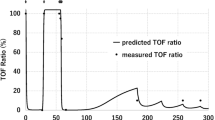Abstract
Propofol is a widely used drug in anesthesia practice, and its pharmacological characteristics are well known. However, propofol is not known for neuromuscular effects. As part of clinical neuromuscular monitoring, the neuromuscular responses to train-of-four (TOF) stimulation were monitored and recorded. We observed, in two cases of balanced anesthesia maintained by desflurane and fentanyl, that administration of a small dose of propofol during almost complete recovery from rocuronium in two patients resulted in marked decreases of both T1 (first twitch response of the TOF) and the TOF ratio. This neuromuscular block dissipated in both patients without any subsequent neuromuscular effects. These two observations provide visual confirmation of the possible impact of propofol on recovery from a rocuronium neuromuscular blockade.

Similar content being viewed by others
References
Brull SJ, Naguib M, Miller RD. Residual neuromuscular block: rediscovering the obvious (editorial). Anesth Analg. 2008;107:11–4.
Miller RD, Sohn YJ, Matteo RS. Enhancement of d-tubocurarine neuromuscular blockade by diuretics in man. Anesthesiology. 1976;45:442–5.
Reves JG, Glass PSA, Lubarsky DA, McEvoy MD, Martinez-Ruiz R. Intravenous anesthetics. In: Miller RD, et al., editors. Anaesthesia. Philadelphia: Elsevier Churchill Livingstone; 2009. p. 719–68.
Vanlersberghe C, Camu F. Propofol. In: Schüttler J, Schwilden H, editors. Modern anesthetics. Handbook of experimental pharmacology. Heidelberg: Springer; 2008. p. 227–52.
Tassonyi E, Charpantier E, Muller D, Dumont L, Bertrand D. The role of nicotinic acetylcholine receptors in the mechanisms of anaesthesia. Brain Res Bull. 2002;57:133–50.
Björnström K, Turina D, Loverock A, Lundgren S, Wijkman M, Lindroth M, Eintrei C. Characterisation of the signal transduction cascade caused by propofol in rat neurons: from the GABAA-receptor to the cytoskeleton. J Physiol Pharmacol. 2008;59:617–32.
Oscarsson A, Massoumi R, Sjölander A, Eintrei C. Reorganization of actin in neurons after propofol exposure. Acta Anaesthesiol Scand. 2001;45:1215–20.
Suzuki T, Munakata K, Watanabe N, Katsumata N, Saeki S, Ogawa S. Augmentation of vecuronium-induced neuromuscular block during sevoflurane anaesthesia: comparison with balanced anaesthesia using propofol or midazolam. Br J Anaesth. 1999;83:485–7.
Scheller MS, Zornow MH, Saidman LJ. Tracheal intubation without the use of muscle relaxant using propofol and varying doses of alfentanil. Anesth Analg. 1992;75:788–93.
Hemmerling TM, Le N. Brief review. Neuromuscular monitoring: an update for the clinician. Can J Anesth. 2007;54:58–72.
Acknowledgments
The authors are indebted to the patients, our anesthesia colleagues, and the surgical teams for their support and cooperation. The authors thank Gertrud Haeseler, MD, PhD (Associate Professor, Hannover Medical School) for her contribution to the discussion of pharmacological aspects. Financial support was provided by the Department of Anesthesia and Perioperative Care University of California San Francisco.
Conflict of interest
None.
Author information
Authors and Affiliations
Corresponding author
About this article
Cite this article
Ruschulte, H., Ward, T.A., Miller, R.D. et al. Possible augmentation of neuromuscular blockade by propofol during recovery from rocuronium. J Anesth 25, 438–441 (2011). https://doi.org/10.1007/s00540-011-1109-4
Received:
Accepted:
Published:
Issue Date:
DOI: https://doi.org/10.1007/s00540-011-1109-4




